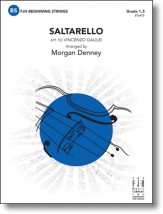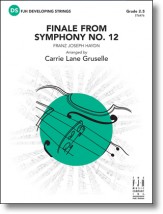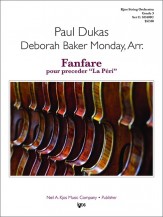Orchestra Classics for Grade 1-3 Monday, September 23, 2019
 recommended by Dan C. and Megan W., Orchestra Specialists
recommended by Dan C. and Megan W., Orchestra Specialists
Water Music (Minuet & Bourree) by G.F. Handel/arr. Carrie Lane Gruselle, Grade 1
Feature this amazingly authentic arrangement of a Baroque masterpiece! Two movements from Handel’s “Water Music Suite No. 2” highlight some of the most famous music from the Baroque era while falling well within the technical capability of a young orchestra. Wonderful music with a vast amount of teaching opportunities!
TEACH • martelé/detaché, dynamic contrast, G string notes, trill
ORCHESTRATION • everyone active with lots of unison rhythms
PERFORMANCE • Water Music a perennial favorite for all involved
 Saltarello by Vincenzo Galilei/arr. Morgan Denney, Grade 1.5
Saltarello by Vincenzo Galilei/arr. Morgan Denney, Grade 1.5
This lively triple-meter dance from the 16th century is very popular with classical guitarists and is now a wonderful addition to the string orchestra repertoire. Pizzicato accompaniments interact with a playful melody that is cleverly developed throughout the ensemble. A delightful work perfect as a change of pace on any program.
TEACH • eighth notes slurred & separate, passing melody, pizzicato accompaniment
ORCHESTRATION • generously shared melody to be brought out
PERFORMANCE • Italian “saltare” is “to jump” for a lively dance
 Mahler’s Mysterious March by Gustav Mahler/arr. Jim Palmer, Grade 1.5
Mahler’s Mysterious March by Gustav Mahler/arr. Jim Palmer, Grade 1.5
This piece is based on a minor version of “Frère Jacques” as heard in Gustav Mahler’s first symphony. The haunting melody and creative variations will capture the students’ interest right away. The wide range of dynamics and contrasting styles in this theme and variation setting create a beautiful piece for the concert and festival stage.
TEACH • contrasting dynamics & styles, C & F natural in E minor
ORCHESTRATION • three variations give everyone the spotlight
PERFORMANCE • rare to get to play Mahler at this grade level
 Brandenburg Concerto #5 by J.S. Bach/arr. Richard Meyer, Grade 1.5
Brandenburg Concerto #5 by J.S. Bach/arr. Richard Meyer, Grade 1.5
The famous first movement of Bach’s “Brandenburg Concerto No. 5,” arranged by Richard Meyer, has been simplified and shortened for the first-year player but still retains all the energy and spirit of the original. It uses only the notes of the D major scale (including a few “high E’s” for Violin I), and the rhythms are within reach of players with very little experience. The perfect selection for your beginning orchestra’s first “real piece,” this arrangement is sure to become a traditional part of your string curriculum.
TEACH • arpeggios, violin 4th finger E, double V, dotted rhythms
ORCHESTRATION • Brandenburgs are busy – no exception here!
PERFORMANCE • standard repertoire every student should know
 Ukrainian Dance (Hopak) by Modest Mussorgsky/arr. Deborah Baker Monday, Grade 2
Ukrainian Dance (Hopak) by Modest Mussorgsky/arr. Deborah Baker Monday, Grade 2
This energetic and lively dance features some of the most delightful themes from Mussorgsky’s original. Based in G Major, this arrangement also showcases some of the composer’s harmonic vocabulary while using very few accidentals. A perfect selection to change the pace of your concert, especially after a heavy work.
TEACH • “circular” bowing, offbeats, simple chromatics, trills
ORCHESTRATION • cascading entrances and Q&A add interest
PERFORMANCE • “leaping & stomping” dance will bring smiles
 Norwegian Dance, Op. 35 #2 by Edvard Grieg/arr. Jeff Bailey, Grade 2.5
Norwegian Dance, Op. 35 #2 by Edvard Grieg/arr. Jeff Bailey, Grade 2.5
What a light and cute contribution to any concert! The use of staccatos in this arrangement serves as a perfect tool to improve and polish ensemble precision. In G Major and all in 1st position.
TEACH • triplets, 16th notes, C#, D#, A#, Eb, Bb, chromatics
ORCHESTRATION • 1st violins share melody with 2nd, violas, cellos
PERFORMANCE • delightful melody sprinkled with ritards & holds
 Finale from Symphony #12 by F.J. Haydn/arr. Carrie Lane Gruselle, Grade 2.5
Finale from Symphony #12 by F.J. Haydn/arr. Carrie Lane Gruselle, Grade 2.5
Treat your students to this spectacular arrangement showcasing the “Father of the Symphony.” This exquisitely orchestrated arrangement teaches a wealth of skills including off-the-string eighth notes, detaché, sixteenth notes, chromatic alterations, and includes abundant opportunities to practice up-beats at the frog. Engaging for every member of the orchestra!
TEACH • detaché 16th notes, low & high fingers, pickups at frog
ORCHESTRATION • activity for everyone in melody and accompaniment
PERFORMANCE • early Haydn opus is refreshingly celebratory
 Slavonic Dance, Op. 46 #3 by Antonin Dvorak/arr. Jim Palmer, Grade 3
Slavonic Dance, Op. 46 #3 by Antonin Dvorak/arr. Jim Palmer, Grade 3
Lively and full of character, this arrangement will be an exciting opener or closer to any concert. Featuring traditional rhythms of Slavic folk music, the piece will give all players a chance to play lyrical melodies as well as exciting dance-like rhythms.
TEACH • end a slur with staccato, offbeats, abrupt tempo change
ORCHESTRATION • everyone but basses gets melodic material
PERFORMANCE • Dvorak’s Slavonic Dances are always a treat
 Fanfare from La Peri by Paul Dukas/arr. Deborah Baker Monday, Grade 3
Fanfare from La Peri by Paul Dukas/arr. Deborah Baker Monday, Grade 3
Originally composed for brass, this extraordinary prelude is now available for string orchestra! Dukas wrote it to precede the beginning of his ballet, “La Peri,” to help patrons settle into their seats for the opening of the ballet. A stunning opener for any concert!
TEACH • subdivision, 20th century harmony, French instructions
ORCHESTRATION • everyone has equal musical challenges
PERFORMANCE • an impressive concert opener when polished
Need more classics for your orchestra? Find more on our website, or contact us to brainstorm ideas. Shop Stanton’s for all your sheet music needs!
About the Authors:
Dan C. has worked at Stanton’s since 1979, primarily with orchestra music and print promotions. A “working” musician, he’s a classical cellist, a rock & jazz bassist and a folk & country guitarist/singer. His free time is spent with family or reading, gardening, cycling and working puzzles. His series of musical puzzles (RP3 Rebus Puzzle Picture People) can be found on the Stanton’s Facebook page each Sunday. He also has a reputation as a pretty good joke teller, and is recently retired – congrats, Dan!
Megan W., originally from Pittsburgh PA, is happy to call Columbus and Stanton’s Sheet Music “Home.” As a musician, Megan has played in marching and concert bands, youth orchestras, full orchestras, small ensembles, and a few choirs. Her interests include fiddling, reading, writing, martial arts and yoga.